Katas Raj Mandir
Katas Raj Mandir near Chakwal in Pakistan’s Punjab region is dated to Hindu Shahis (kings) from 615 to 950 CE and is devoted to Lord Shiva. As such, Katas Raj Mandirs have become one of the most important Hindu pilgrimage sites in Pakistan and are still used by members of the country and those who travel there every year from overseas. Katas Raj Mandir, also known as Qila Katas, is a Hindu temple in Katas, near Choa Saidanshah, some 40 kilometers from Chakwal city in Punjab, Pakistan. Katas Raj Temples are dedicated to Lord Shiva and date from the Hindu Shahi dynasties, which are approximately the 615 to 950 CE eras.
Katas Raj
According to Hindu mythology, the foundation of these Qila Katas was laid by Krishna, who also installed a Shiva ling there. A holy pond can be located in the temple. According to a Brahmanical tradition, the pond was formed by Shiva’s sorrowful tears after the death of his wife, Sati. Today, the Hindu pilgrims visit Katas Raj Chakwal to swim in the pool to beg forgiveness for their sins. Concerning the origins of Katas Raj, The Pandawa brothers, who are a subject of the tremendous poetic epic of “Mahabharta,” are said to have visited the place, and this temple, the mandir, i.e., was built to honor their presence. It is stated that this is the region in the epic known as Dvaitavana.
The Pandavas dwelt during their exile, and the sequence of questions between the Pandavas and the Yakshahs took place. The Sath Ghara, or Seven Temples, is considered to be the spot where the Pandavas lived during their 12-year exile. Before its Hindu roots, the location was home to a Buddhist stupa. Alexander Cunningham, the first Director General of the Archaeological Survey of India, described the temples as standing 61 m (200 ft) tall and surrounded by ten streams from 1872–1873 CE. This supported the Chinese pilgrim Xuan Xang’s account of his visit to this area in the seventh century CE and his description of the numerous Buddhist sites on the subcontinent.
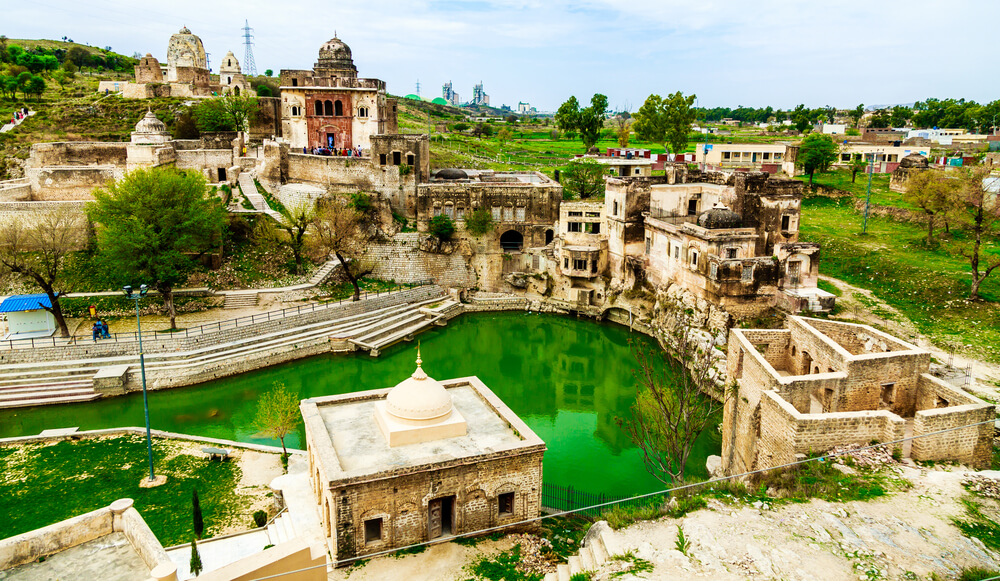
According to Cunningham, the complex of seven temples at the site’s highest point is its most significant feature, keeping visitors in utter marvel. But since the initial report, it has been about 130 years, so there are more signs of decay today compared to 1872. Katas Raj Temples‘ design is reminiscent of Kashmiri temples built during the Karkota and Varma dynasties’ 625–939 CE era. Most temples along the Salt Range’s small hills share certain features, including dentiles, trefoil arches, fluted pillars, and pointed roofs.
Soft sandstone is the primary building material and is covered with plaster for additional support. The makeup of the design and architect triggers the viewer to the prior history of these temples and how the structures stood the test of a long time and still managed to captivate the spectators by their architect. As a result, Katas Raj has a collection of structures and ruins that run uninterruptedly from the Buddhist era to the British subcontinent administration, retaining at least 1500 years of history in that area.
Katas Raj Temples History
There is great importance to the sight concerning the site’s early history, which is vaguely alluded to by the various Archaeological relics still buried underground in the Salt Ranges. At some nearby locations, numerous vertebrae and limb bones of animals have been discovered. At the Katasraj site, prehistoric granite axes, knives, terracotta pots, and bangles have also been found. Although they haven’t been given a date, the latter has been discovered to be comparable to those in Harappa. This suggests that prehistoric human beings densely populated the area around the site.
According to Hindu belief, the temples were built around the time of the Mahabharata and are thought to have housed the Pandava brothers for a significant amount of their exile. Hindus also consider the location of the Yaksha Prashna’s account of the Pandavas’ participation in a riddle competition with the Yakshas, which bears a specific mythological significance to Hinduism.
Katas Raj was mentioned in the travel journals of a Chinese monk named Faxian around 1500 years ago. In the 3rd century BCE reign of an Indian emperor Ashoka the great’s Buddhist stupa, was discovered in the region by the Chinese explorer Xuanzang, who lived in the 7th century CE. According to reports, the stupa was 200 feet tall and had ten water springs.
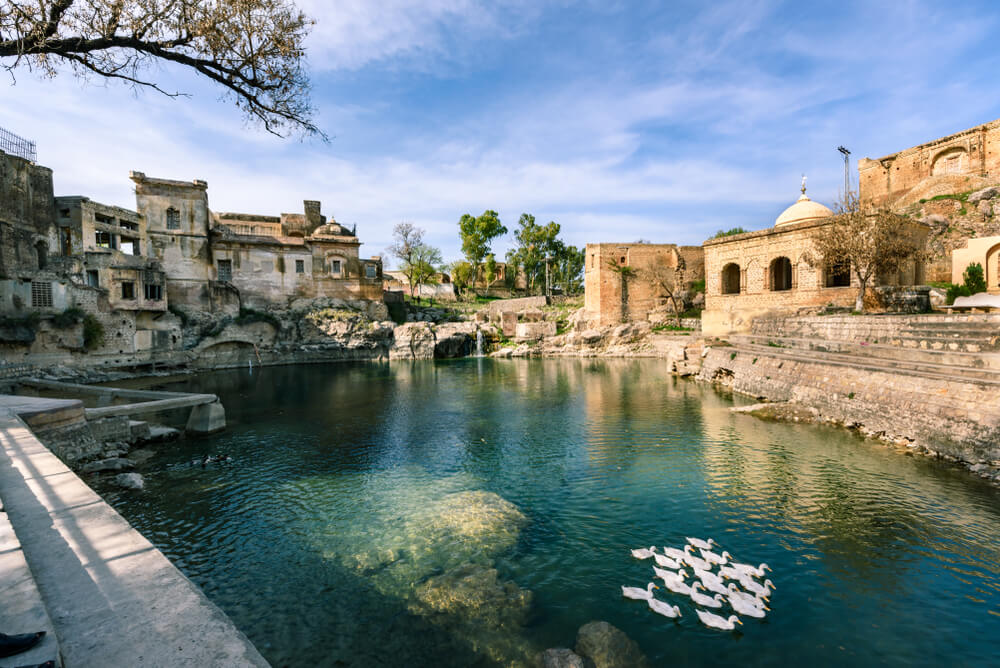
Alexander Cunningham linked Katas Raj to the Buddhist kingdom of Simhapura, also known as Singapura, which Xuanzang wrote about and visited. Beginning in the 7th century CE, the Hindu Shahi empire spread Hinduism throughout the region after the fall of the Gandharan empire. The Hindu Shahis built Hindu temples in Katas Raj from the middle of the 7th to the 10th centuries. The Hindu Shahi empire also provided funding for constructing numerous other temples across northern Punjab and the Potohar province.
The minor temples were constructed in pairs surrounding the main temple approximately 900 years ago, with the earliest dating to the second half of the sixth century AD. Hindus left the temple complex empty when they moved to East Punjab in 1947; nobody stayed behind. Hindus and the neighborhood’s Muslim population got along well. Even local Muslims traveled with them to the following town, Choa Saiden Shah, from whence the Katas Hindu community continued to India. Hindus from northern Punjab have long traveled there to perform the religious pilgrimage.
It is thought that Shiva spent the years of his marriage with Sati here. When Sati famously passed away, Shiva’s grief consumed him, and a pond was created from his tears, which he poured onto the ground in his sad and grief-laden lament. Hinduism claims that swimming in the pond, especially at specific times of the year, results in the forgiveness of sins and aids in achieving salvation. Therefore, the pilgrims dip in the holy pool and ask for forgiveness.
The pond’s depth was thought to be infinite until recently. All Hindu faiths continue to make pilgrimages to the Katas Raj Temples today. The temple complex had been in disrepair for decades. The holy pond was strewn with debris, and the murals within the temples had vanished owing to the hard usage of time and the authorities’ carelessness. In 2005, India’s former deputy prime minister Lal Krishna Advani toured the temples, and in 2006, Pakistan proposed restoring the temple complex. Murtis, or Hindu god idols, were installed in the seven temples for Rs. 51.06 million. A three-person archaeological team traveled to India, Sri Lanka, and Nepal to gather murtis of Hindu gods.
The temple pond had dried up by 2012 due to groundwater being diverted for industrial reasons, while the local cement mill was briefly shut down to replenish water levels. Pakistani authorities began installing shikharas on temples in January 2017 and a water filtration system to give drinkable water to pilgrims. The Water level, which is kept at a moderate amount that is; balanced, in the sacred pond began to decline in quantity again in May 2017.
The temple gained national attention in 2016 after its centuries-old water pond dried up due to groundwater depletion brought on by the construction of four significant cement plants nearby. The Supreme Court of Pakistan took a suo moto notice after receiving the threat and began hearing the matter in November. Mian Saqib Nisar, the Chief Justice of Pakistan, commented on the proceedings that cement manufacturers were using water worth millions of rupees without paying their fair share. He argued that factories should pay taxes and that the court would step in to handle the situation if the government refused.
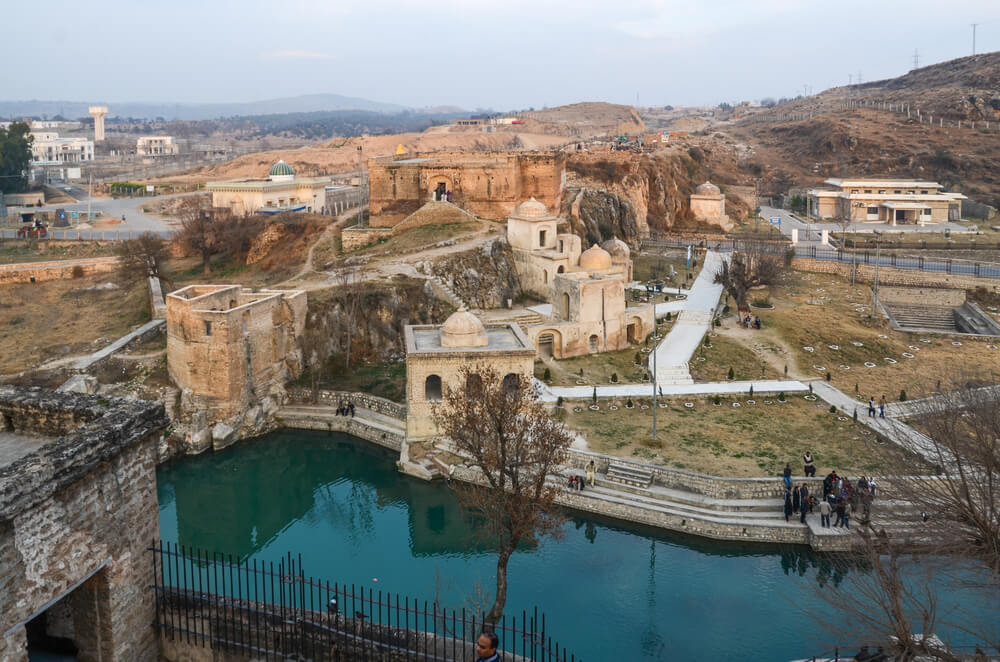
2017’s hearing of the case, Nisar emphasized, “This temple is a treasured element of our country’s history as well as the Hindu community’s cultural center. We must defend it.” When the matter was being heard, the court’s bench also voiced concern over the removal or absence of idols from the temples and demanded to know why there were no statues of Shiri Ram and Hanuman.
A former chairman of the Evacuee Trust Property Board (ETPB) received millions of rupees in bribes during his term, and only after his fleeing Pakistan was the bench informed. The highest court issued its decision in the case in May 2018. It mandated that the cement firms immediately obtain water from a different source and pay the Government of Punjab, Pakistan, for the water they use in the interim. It instructed the cement manufacturers at Bestway and DG Khan to obtain their water requirements from any other alluvial source, such as the Jhelum River.
The authorities cut off the water supply in August 2018 after the enterprises disregarded court directives. As of September 2018, however, it is still being determined what will become of the temple pond because two other cement plants, Gharibwal Cement and Dangote Cement, which are nearby but outside the red zone, continue to use the area’s groundwater for industrial purposes.
The Architecture of Katas Raj Temple
The Satyagraha, a complex collection of seven old temples, may be seen at the Katas site. These are the original remnants of a Buddhist stupa, five other medieval temples, and Havelis that had since been dispersed around a pond. For Hindus, even today, this pond is considered divinely sacred. Most temples in Katas are built on square platforms, a well-known and widely used architectural design in the middle east in the sixth century. The sub-shrine elevation resembles a sequence of cornices with short rows of pillars topped by ribbed domes. The seven temples were constructed using dentils, fluted pillars, trefoil arches, and pointed and immersed rooflines, akin to Kashmiri temple architecture.
Moreover, The Ramachandra Mandir is located towards the east of the Hari Singh Haveli and has only one entrance on the east; all other sides are closed. The two-story building includes eight different-sized rooms on the ground floor and a stairway leading to the first floor at the south. There are two severely damaged jharokhas (balconies) in the mandir.
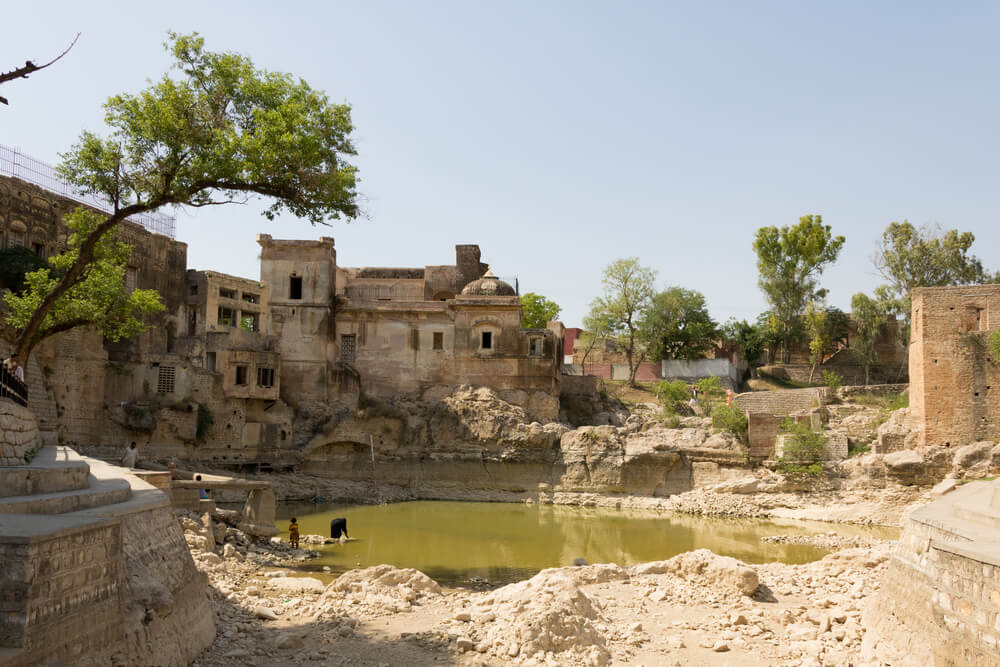
A high structure in a rectangular enclosure with entrances on the south and north contains the Hanuman Mandir at its westernmost point. The temple’s ceiling is lime-plastered and unadorned, in the traditional style, which speaks of its history retrospectively. On another square platform, the Shiva temple is also constructed. It has a rectangular opening to the north and a recessed round arch with faint cusps, which by time, are rendered weak, indicating the general entry to the temple.
In the period which indicated the reign of Hari Singh Nalwa, a modest fort and residence were built for his usage as a military fort and personal dwelling. The fort is situated on a tiny hill overlooking the central area of the temple complex, which was a refreshing view for the ruler who resided there. The fort is rectangular and has four bastions, one in each corner. The fort’s walls are roughly 5 meters tall, with an entryway in the western wall. The fort’s middle section includes a small courtyard surrounded by an arched veranda. The interior rooms were unadorned.
What is the Meaning of Katas Raj?
The name “Katas Raj” derives from the Sanskrit word “kataksha,” which means “tearful eyes.” Local Hindu mythology holds that Lord Shiva sobbed uncontrollably after the passing of his beloved bride Sati. The ponds at Katas Raj were created by his tears that fell on the ground.
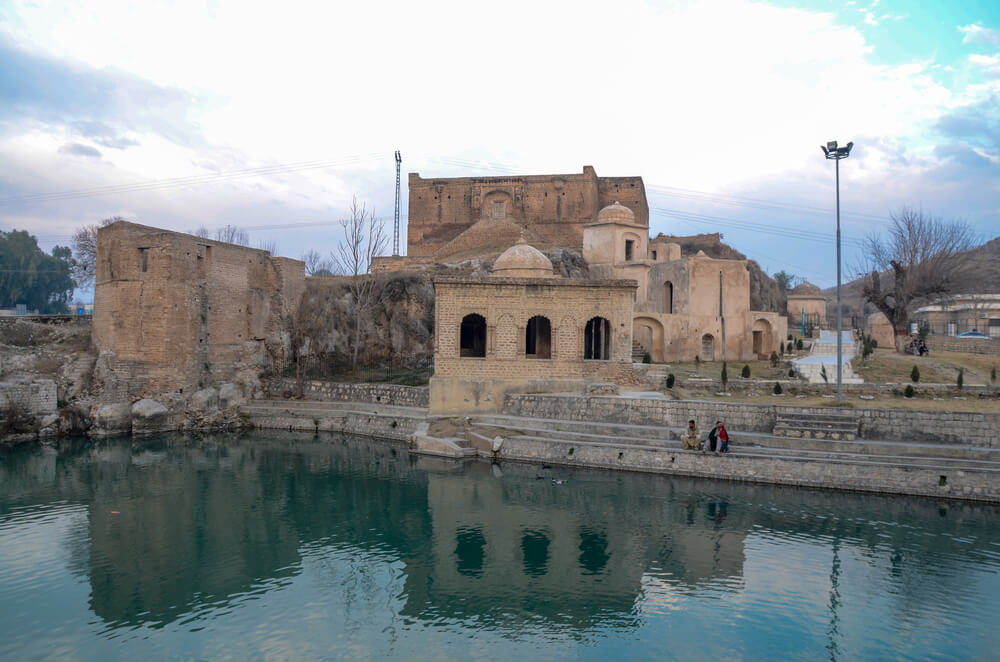
Hence the temples surrounding the pool have long since been known as Katas Raj because of their religious and mythological significance. The pond was first called Viskund, which means “poison spring,” before being called Amarkund, Chamaskund, and lastly, Katakshkund, which means “Spring of sad eyes.” In Urdu and Persian, the pond’s name is Chashm-e-Alam, which translates to “Sorrowful/Tearful Eyes.”
What is another Name for Katas Raj Temples?
The Katas Raj Temples are also frequently alluded to as Qila Katas. In the national language, the word Qila signifies a castle or a fort. Hence the name Qila Katas is relevant among locals around the Katas Raj Temples.
Katas Raj Temples Attractions
The main attraction of the Katas Raj Temples is their religious significance. After the temple at Jwalamukhi in contemporary Himachal Pradesh, the temples in chakwal are regarded as the second most sacred location in the medieval Punjab region. It is conventional wisdom that the Katasraj Temple complex originated during the Mahabharata period. The temples are mentioned in numerous legends. It is supposed that the five Pandava brothers, described in the Mahabharata, spent most of their exile here. According to legend, the complex is where the Yaksha tested the Pandava brothers before allowing them to drink from the pond. The sacred pond of tears is still considered a source of holy water by Hindus.
The Yaksha killed four of the brothers after they failed. Yudhishthira, the fifth brother, challenged the Yaksha to a riddle match and, using his knowledge to triumph, brought his brothers back to life. The temples also have a baradari, also known as havan kund. The baradari is an impressive medieval structure with 12 doors opened for all sides for unrestricted airflow, and pillars support the structure.
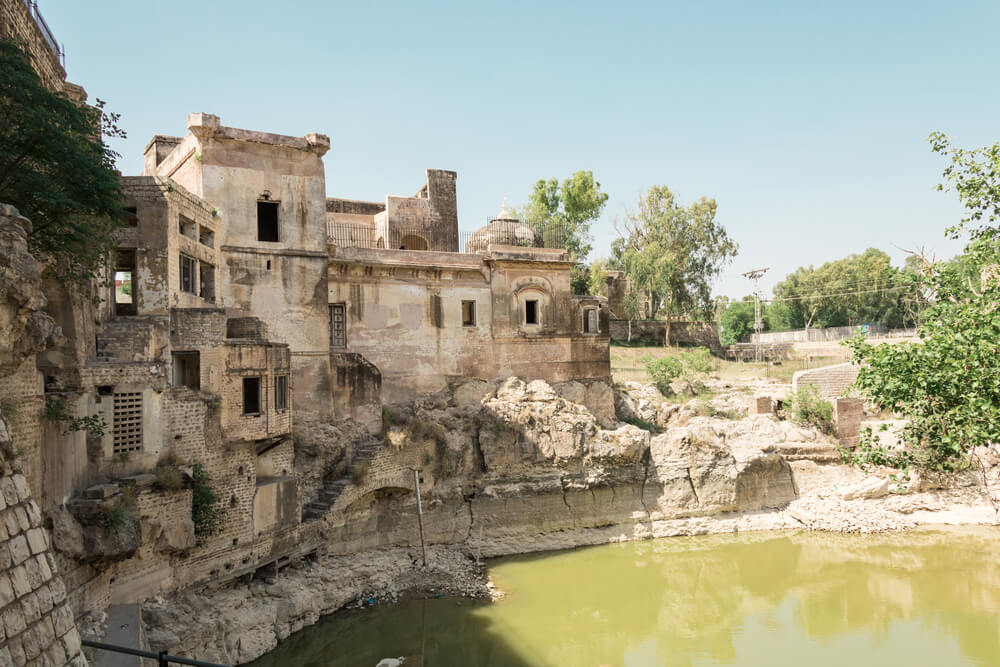
The temples also include the famous temple of Shri shiv, which is elaborately constructed. One of the other beautifully made temples is the Shri Ram Chandra Mandir, which is found in the proximity of other temples like the Hanuman Mandir, which is dedicated to Hanuman. The temples are a part of the original Buddhist stupa remains. The Haveli of Hari Singh Nalwa can still be recognized here. Hari Singh was a ruler in these parts long ago and made his abode amidst the Sath Graha Temple because of the other temples of Katas Raj. It is dedicated to the worship of the Hindu goddess Shiva.
Festivals at Katas Raj Temples
Every year, a sizable contingent of Sikh and Hindu pilgrims from India travel to Pakistan to observe religious festivals following the Pakistan-India agreement on visits to religious shrines from 1974. 200 Hindu pilgrims at most may participate in the cross-border journey. Hindu pilgrims typically travel to Katas Raj twice a year, once in February or March for the Maha Shivratri festival and once in November or December.
The Katas Raj Temple, sometimes called Qila Katas, is a collection of shrines connected by walkways. It is located in Pakistan’s Punjab province’s Chakwal district, is known in far corners of the middle east, and is revered by religious Hindu minorities in Pakistan. For Sikhs as well, the site is essential historically and religiously. The Katas Raj Temples are thought to have been visited by Guru Nanak, the founder of the Sikh religion, as the location became well-liked among ascetics. Ranjit Singh, the Sikh monarch, visited the area on pilgrimage regularly. He returned to the place for the Vaisakhi celebration in 1806, December 1818, and 1824.
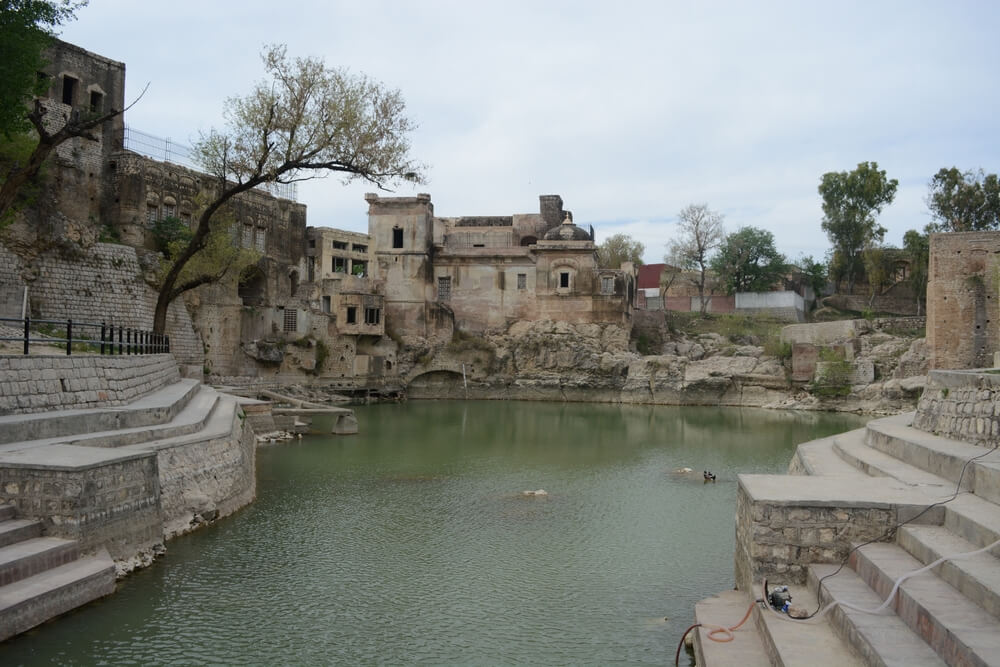
Before the 1947 Partition of British India, the complex was a well-known Hindu pilgrimage site, and many Hindus came for Shivratri. The indigenous Hindu population fled the area for India after Partition. The local Muslim population got along well with the Hindus, and they traveled together to the town of Choa Saiden Shah, where the local Hindu population left for India. When the Indo-Pakistani War broke out in 1965, Indian pilgrims could no longer attend the shrine during the Shivratri festival. But that changed, and the ban was lifted in 1984.
How to Get to Katas Raj Temples?
The car travel distance from the Karachi mainland follows a drive of about 12 hours. From Islamabad, the distance is about 150km and can be covered in 2 hours.
Katas Taj Temple Location
The precise location for digital maps is: PXF2+HMR, Kalar Kahar Rd, Katas, Chakwal, Punjab
FAQs
How old are Katas Raj Temples?
The age of temples ranges between 2,500 to 2,900 years. The smaller temples were added about 900 years ago.
Who made Katas Raj Temples?
The initial temples were built by the emperor Ashoka.
Why is the Katas Raj Temple famous?
They are famous for their religious, cultural, and historical significance to Hindus, Sikhs, and Buddhists.
Can Indian visit Katas Raj temple?
Yes, Indians can visit, and the visits to these temples under Pakistan-India 1974 protocol emphasize safety for international travelers.
Conclusion
This site bears great importance for both Hindus and non-Hindus and should be respective, irrespective of religious affiliations. The historical significance of the temples proves how these significant medieval landmarks have stood the great test of time and continue to enthrall even non-believers visually. Hence, following its cultural heritage, every Pakistani should at least once visit these beautifully constructed temples; they do not fail to elicit the feeling of taking a walk through the history of whoever visits them. These temples will be the ideal destination for amateur historical enthusiasts and scholars.
